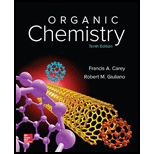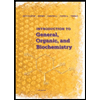
Organic Chemistry - Standalone book
10th Edition
ISBN: 9780073511214
Author: Francis A Carey Dr., Robert M. Giuliano
Publisher: McGraw-Hill Education
expand_more
expand_more
format_list_bulleted
Concept explainers
Textbook Question
Chapter 27, Problem 18P
Nebularine is a toxic nucleoside isolated from a species of mushroom. Its systematic name is
Expert Solution & Answer
Want to see the full answer?
Check out a sample textbook solution
Students have asked these similar questions
What happens when the codeine molecule (C18H21NO3) is exposed to air? What reactions are obtained?
What is the principle behind the isolation of albumin?
Draw the structure of the tetrapeptide Asp-Arg-Val-Tyr. Please show the appropriate stereochemistry of the natural amino acids in the resulting peptide. Please draw all ionizable groups in their neutral form.
Chapter 27 Solutions
Organic Chemistry - Standalone book
Ch. 27.1 - Problem 27.1 Write a structural formula for the...Ch. 27.1 - Prob. 2PCh. 27.1 - Prob. 3PCh. 27.2 - Prob. 4PCh. 27.3 - Prob. 5PCh. 27.3 - Prob. 6PCh. 27.5 - Prob. 7PCh. 27.5 - Prob. 8PCh. 27.5 - Prob. 9PCh. 27.6 - Prob. 10P
Ch. 27.7 - Prob. 11PCh. 27.9 - Prob. 12PCh. 27.12 - 27.13 Modify Figure 27.12 so that it corresponds...Ch. 27.13 - Prob. 14PCh. 27 - Prob. 15PCh. 27 - Prob. 16PCh. 27 - Prob. 17PCh. 27 - Nebularine is a toxic nucleoside isolated from a...Ch. 27 - Prob. 19PCh. 27 - The 5-nucleotide of inosine, inosinic acid...Ch. 27 - Prob. 21PCh. 27 - (a) The two most acidic hydrogens of uracil have...Ch. 27 - The phosphorylation of -D-glucopyranose by ATP...Ch. 27 - When 6-chloropurine is heated with aqueous sodium...Ch. 27 - Prob. 25PCh. 27 - Prob. 26PCh. 27 - Prob. 27PCh. 27 - Prob. 28PCh. 27 - Oligonucleotide Synthesis In Section 27.6 we noted...Ch. 27 - Oligonucleotide Synthesis In Section 27.6 we noted...Ch. 27 - Oligonucleotide Synthesis In Section 27.6 we noted...Ch. 27 - Oligonucleotide Synthesis In Section 27.6 we noted...Ch. 27 - Oligonucleotide Synthesis In Section 27.6 we noted...Ch. 27 - Oligonucleotide Synthesis In Section 27.6 we noted...
Knowledge Booster
Learn more about
Need a deep-dive on the concept behind this application? Look no further. Learn more about this topic, chemistry and related others by exploring similar questions and additional content below.Similar questions
- Define tautomerism and use one of the structures above to illustrate your explanationarrow_forwardThe first amino acid incorporated into a polypeptide chain during its biosynthesis in prokaryotes is N-formylmethionine. Explain the purpose of the formyl grouparrow_forwardThe amino acid (S)-alanine has the physical characteristics listed under the structure. a.What is the melting point of (R)-alanine? b.How does the melting point of a racemic mixture of (R)- and (S)-alanine compare to the melting point of (S)-alanine? c. What is the specific rotation of (R)-alanine, recorded under the same conditions as the reported rotation of (S)-alanine? d.What is the optical rotation of a racemic mixture of (R)- and (S)-alanine? e.Label each of the following as optically active or inactive: a solution of pure (S)alanine; an equal mixture of (R)- and (S)-alanine; a solution that contains 75% (S)- and 25% (R)-alanine.arrow_forward
- The amino acid (S)-alanine has the physical characteristics listed under the structure. How does the melting point of a racemic mixture of (R)- and (S)-alanine compare to the melting point of (S)-alanine?arrow_forwardDraw beta-L-erythrofuranosearrow_forwardTreatment of a new protein with dansyl chloride reveals two (2) dansyl-labelled derivatives of amino acids, alanine and methionine. What can you deduce about the structure of the proteinfrom these results?arrow_forward
- Suggest a scheme you will follow to synthesise the dipeptide Ala-Glyarrow_forwardConstruct the primary structure of the polypeptide MethionylLeucylGlycylLeucylValine in trans configuration and write its nomenclaturearrow_forwardChorismate mutase is an enzyme that promotes a pericyclic reaction by forcing the substrate to assume the conformation needed for the reaction. The product of the pericyclic reaction is prephenate that is subsequently converted into the amino acids phenylalanine and tyrosine. What kind of a pericyclic reaction does chorismate mutase catalyze?arrow_forward
arrow_back_ios
SEE MORE QUESTIONS
arrow_forward_ios
Recommended textbooks for you
 Introduction to General, Organic and BiochemistryChemistryISBN:9781285869759Author:Frederick A. Bettelheim, William H. Brown, Mary K. Campbell, Shawn O. Farrell, Omar TorresPublisher:Cengage Learning
Introduction to General, Organic and BiochemistryChemistryISBN:9781285869759Author:Frederick A. Bettelheim, William H. Brown, Mary K. Campbell, Shawn O. Farrell, Omar TorresPublisher:Cengage Learning

Introduction to General, Organic and Biochemistry
Chemistry
ISBN:9781285869759
Author:Frederick A. Bettelheim, William H. Brown, Mary K. Campbell, Shawn O. Farrell, Omar Torres
Publisher:Cengage Learning
Biomolecules - Protein - Amino acids; Author: Tutorials Point (India) Ltd.;https://www.youtube.com/watch?v=ySNVPDHJ0ek;License: Standard YouTube License, CC-BY